Assessment of Polar Ionospheric Observations by VIPIR/Dynasonde at Jang Bogo Station, Antarctica: Part 1—Ionospheric Densities
Abstract
1. Introduction
2. Data
2.1. The Observation of Ionospheric Density from JVD
2.2. The Observation of GPS TEC at JBS
3. Comparisons between JVD-Observed Densities and GPS TEC Measurements
4. Common Type of Misestimated Ionospheric Density Profiles from the Dynasonde
5. Summary and Conclusions
Author Contributions
Funding
Acknowledgments
Conflicts of Interest
References
- Heelis, R.A.; Lowell, J.K.; Spiro, R.W. A model of the high latitude ionosphere convection pattern. J. Geophys. Res. 1982, 82, 6339–6345. [Google Scholar] [CrossRef]
- Kim, E.; Jee, G.; Ji, E.-Y.; Kim, Y.H.; Lee, C.; Kwak, Y.-S.; Shim, J.-S. Climatology of polar ionospheric density profiles in comparison with mid-latitude ionosphere from long-term observations of incoherent scatter radars: A review. J. Atmos. Solar-Terr. Phys. 2020, 211, 105449. [Google Scholar] [CrossRef]
- Sojka, J.J.; Bowline, M.D.; Schunk, R.W. Patches in the polar ionosphere: UT and seasonal dependence. J. Geophys. Res. 1994, 99, 14959–14970. [Google Scholar] [CrossRef]
- David, M.; Sojka, J.J.; Schunk, R.W.; Coster, A.J. Polar cap patches and the tongue of ionization: A survey of GPS TEC maps from 2009 to 2015. Geophys. Res. Lett. 2016, 43, 2422–2428. [Google Scholar] [CrossRef]
- Rietveld, M.T.; Wright, J.W.; Zabotin, N.; Pitteway, M.L.V. The Tromsø dynasonde. Polar Sci. 2008, 2, 55–71. [Google Scholar] [CrossRef]
- Kwon, H.-J.; Lee, C.; Jee, G.; Ham, Y.-B.; Kim, J.-H.; Kim, Y.H.; Kim, K.-H.; Wu, Q.; Bullett, T.; Oh, S.; et al. Ground-based observations of the polar region space environment at the Jang Bogo Station, Antarctica. J. Astron. Space Sci. 2018, 35, 185–193. [Google Scholar] [CrossRef]
- Ham, Y.-B.; Jee, G.; Lee, C.; Kwon, H.-J.; Kim, J.-H.; Zabotin, N.; Bullett, T. Observations of the polar ionosphere by the Vertical Incidence Pulsed Ionospheric Radar at Jang Bogo station, Antarctica. J. Astron. Space Sci. 2020, 37, 143–156. [Google Scholar] [CrossRef]
- Zabotin, N.A.; Wright, J.W.; Zhbankov, G.A. NeXtYZ: Three-dimensional electron density inversion for Dynasonde ionograms. Radio Sci. 2006, 41, 1–12. [Google Scholar] [CrossRef]
- Belehaki, A.; Jakowski, N.; Reinisch, B.W. Comparison of ionospheric ionization measurements over Athens using ground ionosonde and GPS-derived TEC values. Radio Sci. 2003, 38, 1105. [Google Scholar] [CrossRef]
- McKinnell, L.-A.; Opperman, B.; Cilliers, P.J. GPS TEC and ionosonde TEC over Grahamstown, South Africa: First comparisons. Adv. Space Res. 2007, 39, 816–820. [Google Scholar] [CrossRef]
- Zhu, Q.; Lei, J.; Luan, X.; Dou, X. Contribution of the topside and bottomside ionosphere to the total electron content during two strong geomagnetic storms. J. Geophys. Res. 2016, 121, 2475–2488. [Google Scholar] [CrossRef]
- Cai, H.; Li, F.; Shen, G.; Zhan, W.; Zhou, K.; McCrea, I.W.; Ma, S. E layer dominated ionosphere observed by EISCAT/ESR radars during solar minimum. Ann. Geophys. 2014, 32, 1223–1231. [Google Scholar] [CrossRef]
- Mayer, C.; Jakowski, N. Enhanced E-layer ionization in the auroral zones observed by radio occultation measurements onboard CHAMP and Formosat-3/COSMIC. Ann. Geophys. 2009, 27, 1207–1212. [Google Scholar] [CrossRef]
- Kamal, S.; Jakowski, N.; Hoque, M.M.; Wickert, J. Evaluation of E layer dominated ionosphere events using COSMIC/FORMOSAT-3 and CHAMP ionospheric radio occultation data. Remote Sens. 2020, 12, 333. [Google Scholar] [CrossRef]
- Jee, G.; Ham, Y.-B.; Choi, Y.; Kim, E.; Lee, C.; Kwon, H.; Trondsen, T.S.; Kim, J.E.; Kim, J.-H. Observations of the aurora by visible all-sky camera at Jang Bogo Station, Antarctica. J. Astron. Space Sci. 2021, 38, 203–215. [Google Scholar] [CrossRef]
- Rungraengwajiake, S.; Supnithi, P.; Saito, S.; Siansawasdi, N.; Saekow, A. Ionospheric delay gradient monitoring for GBAS by GPS stations near Suvarnabhumi airport, Thailand. Radio Sci. 2015, 50, 1076–1085. [Google Scholar] [CrossRef]
- Arikan, F.; Nayir, H.; Sezen, U.; Arikan, O. Estimation of single station interfrequency receiver bias using GPS-TEC. Radio Sci. 2008, 43, 1–13. [Google Scholar] [CrossRef]
- Hong, J.; Chung, J.; Kim, Y.H.; Park, J.; Kwon, H.; Kim, J. Characteristics of Ionospheric Irregularities Using GNSS Scintillation Indices Measured at Jang Bogo Station, Antarctica (74.62°S, 164.22°E). Space Weather 2020, 18, e2020SW002536. [Google Scholar] [CrossRef]
- Crowley, G.; Ridley, A.J.; Deist, D.; Wing, S.; Knipp, D.J.; Emery, B.A. The transformation of high-latitude ionospheric F- region patches into blobs during the March 21, 1990 storm. J. Geophy. Res. 2000, 105, 5215–5230. [Google Scholar] [CrossRef]
- Otsuka, Y.; Ogawa, T.; Saito, A.; Tsugawa, T.; Fukao, S. A new technique for mapping of total electron content using GPS network in Japan. Earth Planets Space 2002, 54, 63–70. [Google Scholar] [CrossRef]
- Panda, S.K.; Gedam, S. Robustness of Elevation Cut-off in Estimating Ionospheric Total Electron Content from GPS Observation Data. In Proceedings of the 8th International Conference on Microwaves, Antenna, Propagation & Remote Sensing (ICMARS-2012), Jodhpur, India, 11–15 December 2012. [Google Scholar]
- Hoque, M.M.; Jakowski, N.; Prol, F.S. A new climatological electron density model for supporting space weather services. J. Space Weather Space Climate 2022, 12, 1. [Google Scholar] [CrossRef]
- Scotto, C.; Pezzopane, M. Automatic scaling of polar ionograms. Antarctic Sci. 2011, 24, 88–94. [Google Scholar] [CrossRef][Green Version]
- Shimazaki, T. A statistical study of occurrence probability of spread F at high latitudes. J. Geophys. Res. 1962, 67, 4617–4634. [Google Scholar] [CrossRef]
- Newell, P.T.; Meng, C.I.; Lyons, K.M. Suppression of discrete aurorae by sunlight. Nature 1996, 381, 766–767. [Google Scholar] [CrossRef]
- Borovsky, J.E. Still in the dark. Nature 1998, 393, 312–313. [Google Scholar] [CrossRef]
- Barth, C.A.; Baker, D.N.; Bailey, S.M. Seasonal variation of auroral electron precipitation. Geophys. Res. Lett. 2004, 31, L04809. [Google Scholar] [CrossRef]
- Bates, H.F. HF propagation through the auroral curtain. J. Geophys. Res. 1970, 75, 143–151. [Google Scholar] [CrossRef]
- Kintner, P.M.; Ledvina, B.M.; Paula, E.R. GPS and ionospheric scintillations: Gps and ionospheric scintillations. Space Weather 2007, 5. [Google Scholar] [CrossRef]

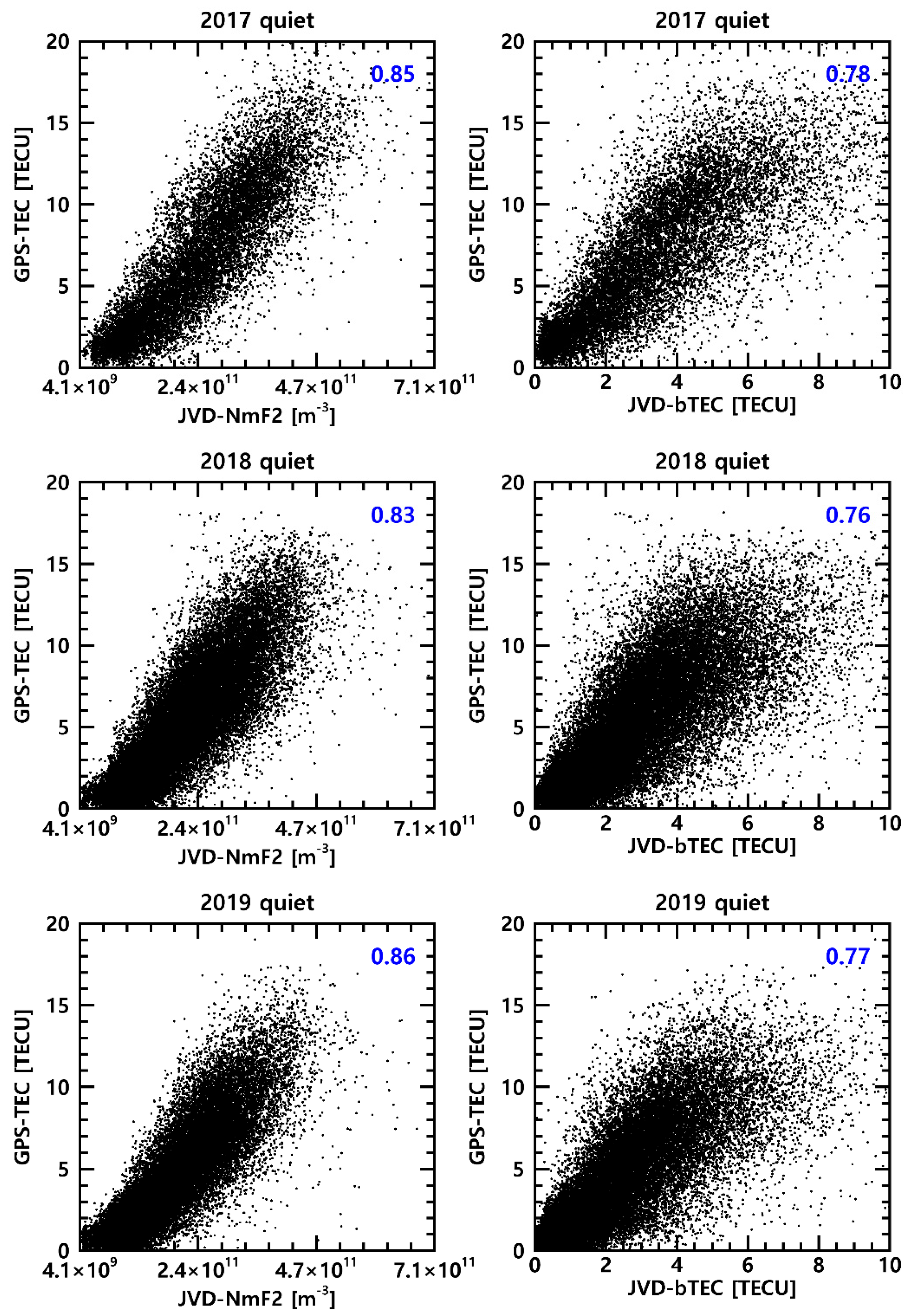
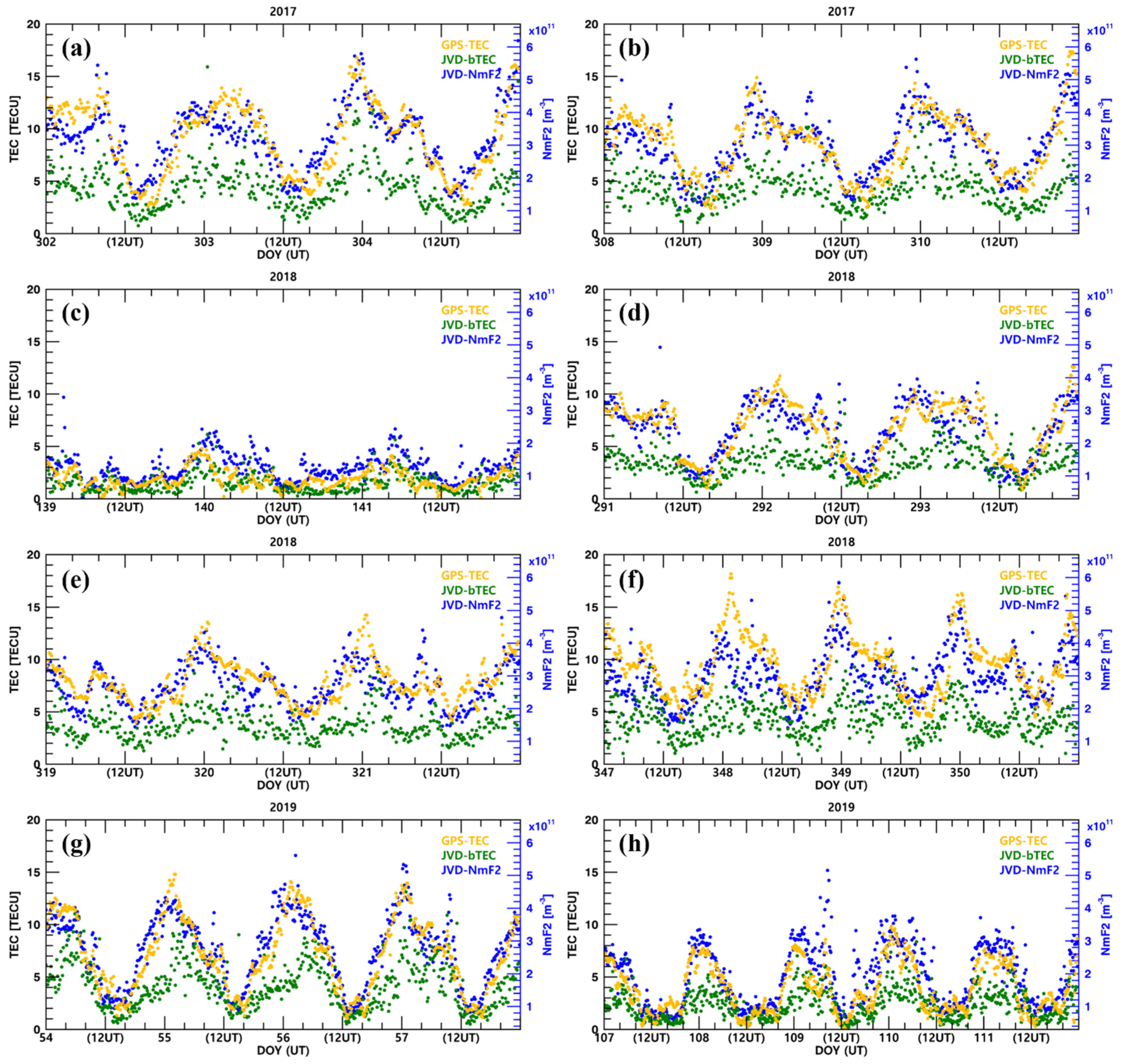
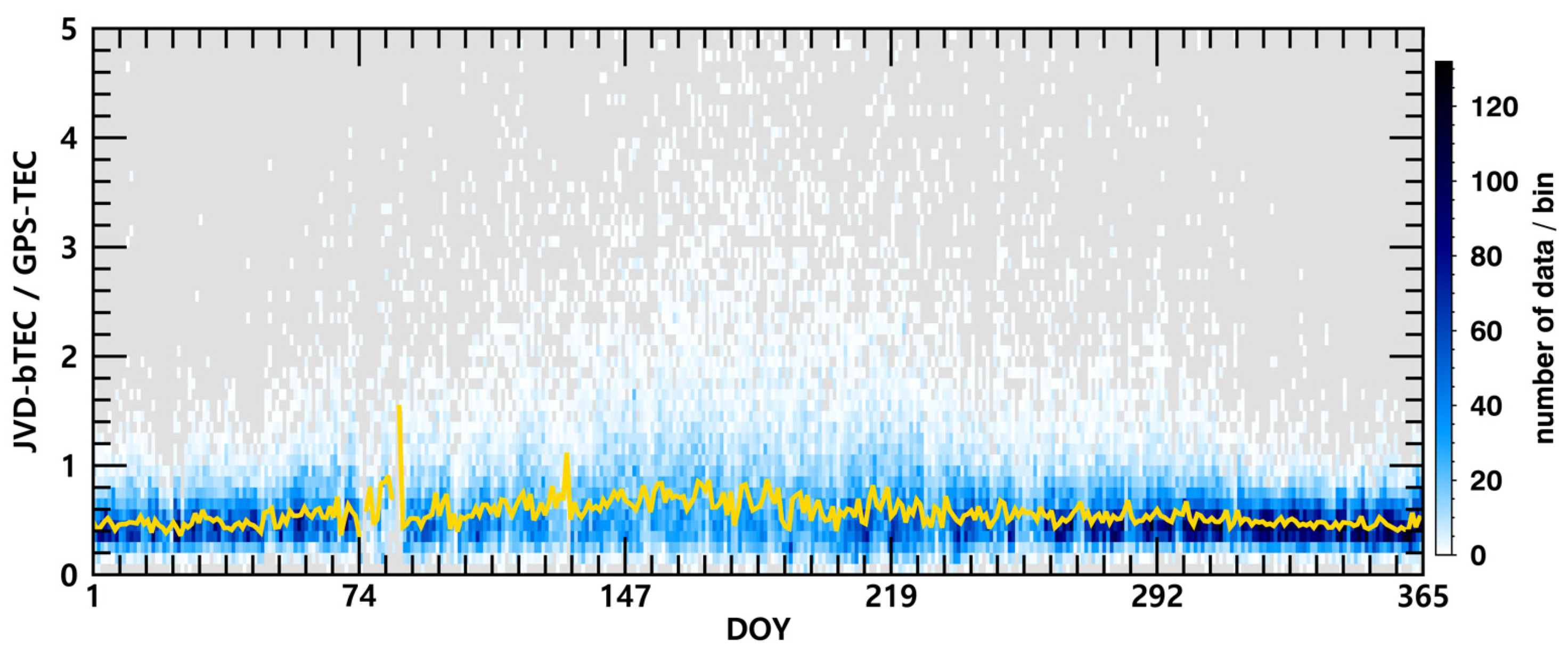

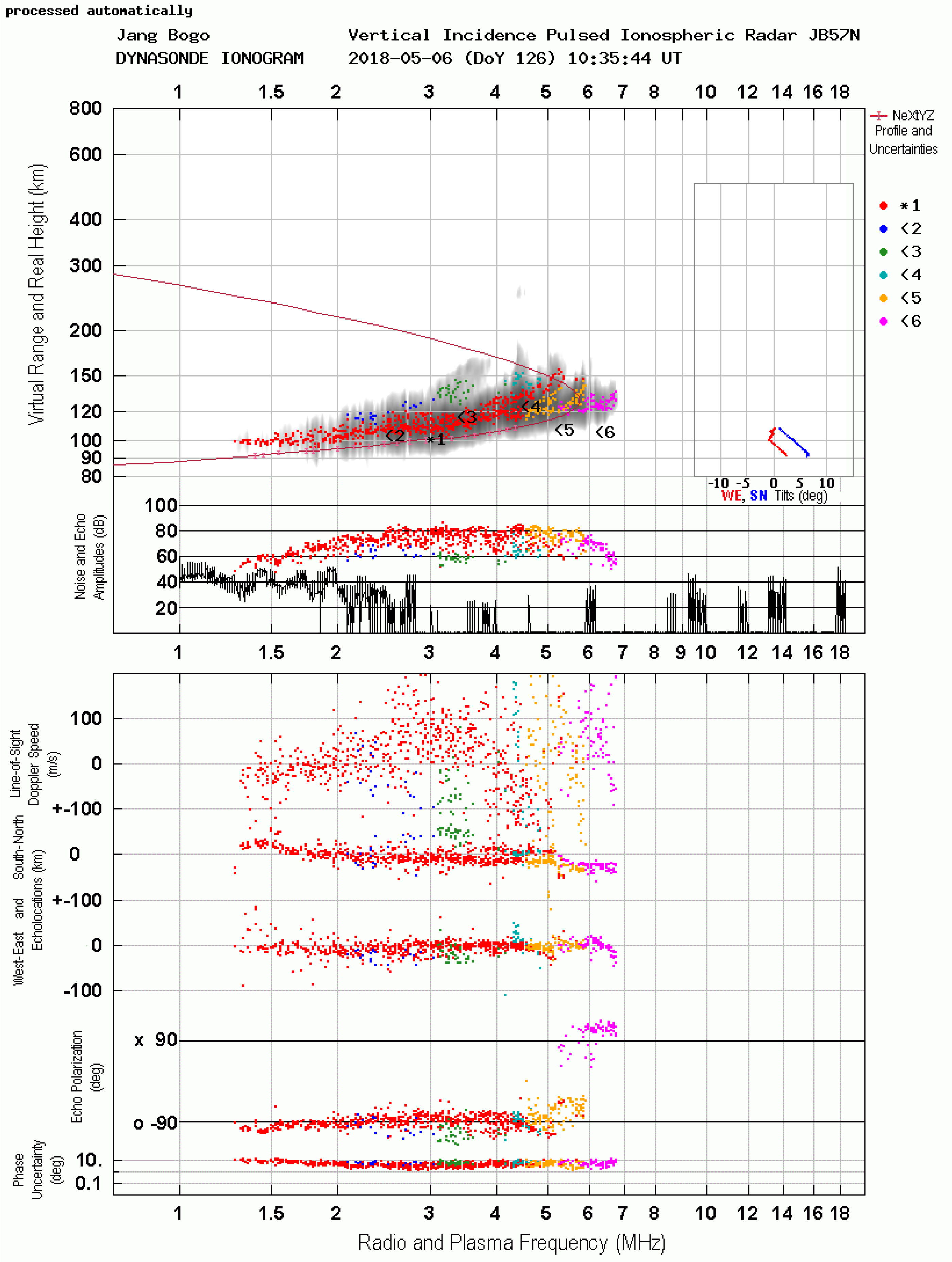
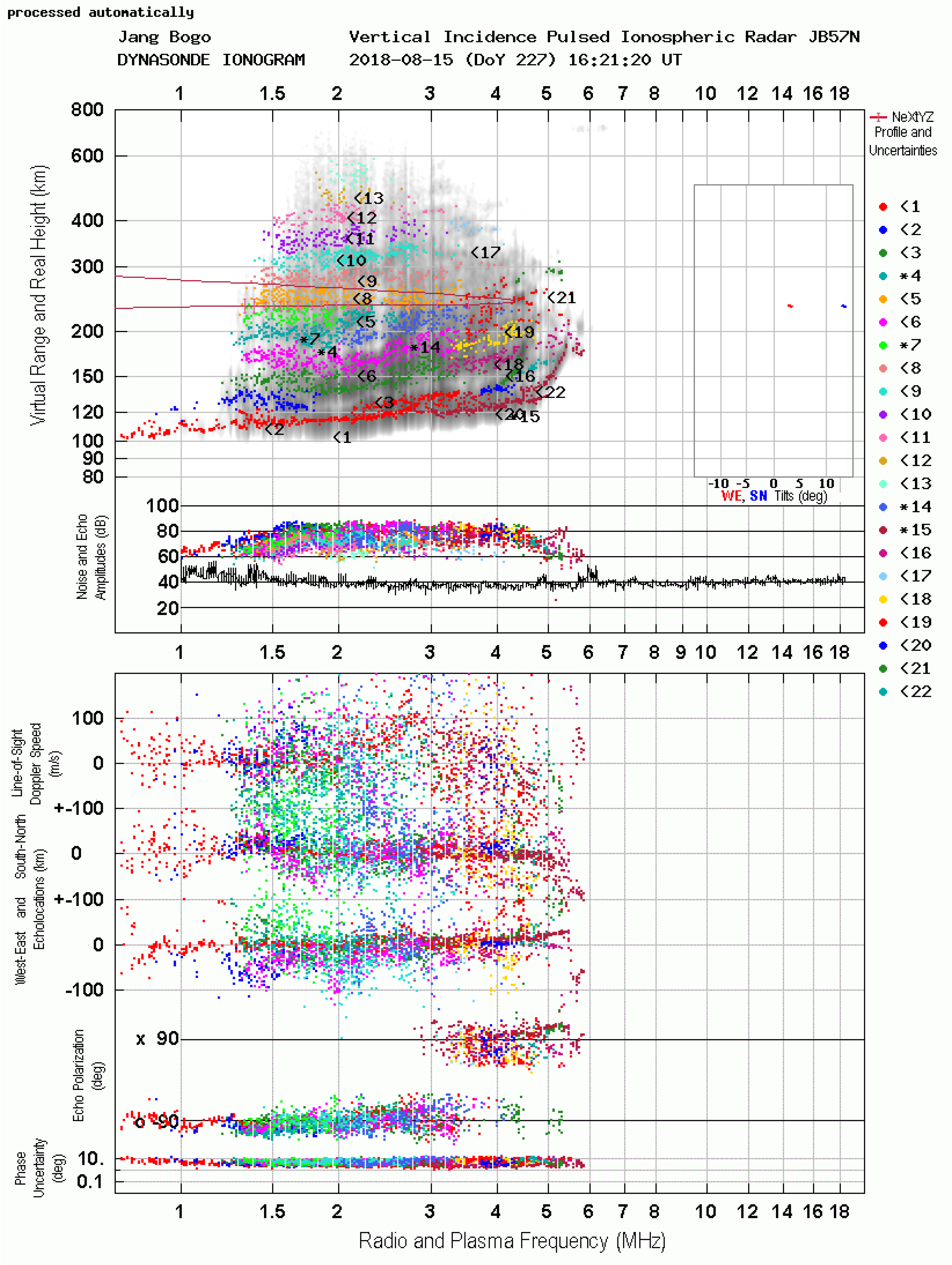
Publisher’s Note: MDPI stays neutral with regard to jurisdictional claims in published maps and institutional affiliations. |
© 2022 by the authors. Licensee MDPI, Basel, Switzerland. This article is an open access article distributed under the terms and conditions of the Creative Commons Attribution (CC BY) license (https://creativecommons.org/licenses/by/4.0/).
Share and Cite
Kim, E.; Jee, G.; Ham, Y.-B.; Zabotin, N.; Lee, C.; Kwon, H.-J.; Hong, J.; Kim, J.-H.; Bullett, T. Assessment of Polar Ionospheric Observations by VIPIR/Dynasonde at Jang Bogo Station, Antarctica: Part 1—Ionospheric Densities. Remote Sens. 2022, 14, 2785. https://doi.org/10.3390/rs14122785
Kim E, Jee G, Ham Y-B, Zabotin N, Lee C, Kwon H-J, Hong J, Kim J-H, Bullett T. Assessment of Polar Ionospheric Observations by VIPIR/Dynasonde at Jang Bogo Station, Antarctica: Part 1—Ionospheric Densities. Remote Sensing. 2022; 14(12):2785. https://doi.org/10.3390/rs14122785
Chicago/Turabian StyleKim, Eunsol, Geonhwa Jee, Young-Bae Ham, Nikolay Zabotin, Changsup Lee, Hyuck-Jin Kwon, Junseok Hong, Jeong-Han Kim, and Terence Bullett. 2022. "Assessment of Polar Ionospheric Observations by VIPIR/Dynasonde at Jang Bogo Station, Antarctica: Part 1—Ionospheric Densities" Remote Sensing 14, no. 12: 2785. https://doi.org/10.3390/rs14122785
APA StyleKim, E., Jee, G., Ham, Y.-B., Zabotin, N., Lee, C., Kwon, H.-J., Hong, J., Kim, J.-H., & Bullett, T. (2022). Assessment of Polar Ionospheric Observations by VIPIR/Dynasonde at Jang Bogo Station, Antarctica: Part 1—Ionospheric Densities. Remote Sensing, 14(12), 2785. https://doi.org/10.3390/rs14122785





